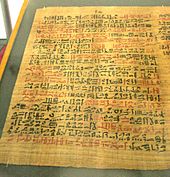Prehistoric times[edit]
Plants, including many now used as culinary herbs and spices, have been used as medicines, not necessarily effectively, from prehistoric times. Spices have been used partly to counter food spoilage bacteria, especially in hot climates,[5][6] and especially in meat dishes which spoil more readily.[7] Angiosperms (flowering plants) were the original source of most plant medicines.[8] Human settlements are often surrounded by weeds used as herbal medicines, such as nettle, dandelion and chickweed.[9][10] Humans were not alone in using herbs as medicines: some animals such as non-human primates, monarch butterflies and sheep ingest medicinal plants when they are ill.[11] Plant samples from prehistoric burial sites are among the lines of evidence that Paleolithic peoples had knowledge of herbal medicine. For instance, a 60,000-year-old Neanderthal burial site, "Shanidar IV", in northern Iraq has yielded large amounts of pollen from eight plant species, seven of which are used now as herbal remedies.[12] Also, a mushroom was found in the personal effects of Ötzi the Iceman, whose body was frozen in the Ötztal Alps for more than 5,000 years. The mushroom was probably used against whipworm.[13]
Ancient times[edit]
In ancient Sumeria, hundreds of medicinal plants including myrrh and opium are listed on clay tablets from around 3000 BC. The ancient Egyptian Ebers Papyrus lists over 800 plant medicines such as aloe, cannabis, castor bean, garlic, juniper, and mandrake.[14][15]
From ancient times to the present, Ayurvedic medicine as documented in the Atharva Veda, the Rig Veda and the Sushruta Samhita has used hundreds of pharmacologically active herbs and spices such as turmeric, which contains curcumin.[16][17] The Chinese pharmacopoeia, the Shennong Ben Cao Jing records plant medicines such as chaulmoogra for leprosy, ephedra, and hemp.[18] This was expanded in the Tang dynasty Yaoxing Lun.[19] In the fourth century BC, Aristotle's pupil Theophrastus wrote the first systematic botany text, Historia plantarum.[20] In around 60 AD, the Greek physician Pedanius Dioscorides, working for the Roman army, documented over 1000 recipes for medicines using over 600 medicinal plants in De materia medica. The book remained the authoritative reference on herbalism for over 1500 years, into the seventeenth century.[4]
You received this message because you are subscribed to the Google Groups "1TopReadys1" group.
To unsubscribe from this group and stop receiving emails from it, send an email to 1topreadys1+unsubscribe@googlegroups.com.
To view this discussion on the web visit https://groups.google.com/d/msgid/1topreadys1/CAEXU47UzT6D_4Fv1vNMEF8FQpNJSYtcqOCJcTU%2BT%3DyKBh0%2B5-w%40mail.gmail.com.

No comments:
Post a Comment